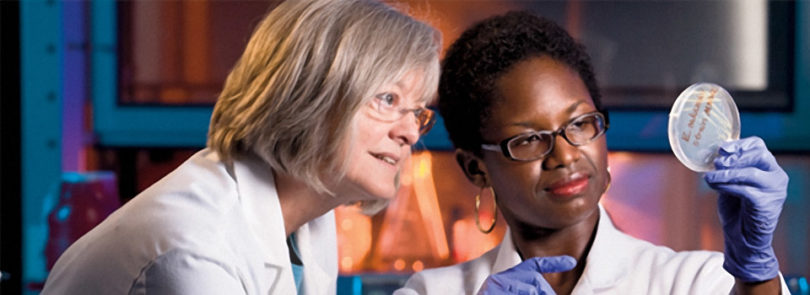Arena N. Richardson considers the red-stained slide of a rod-shaped bacillus named Enterobacter sakazakii, or E. sakazakii. For the past four years, she has studied the bacterium under the oversight of her professor, toxicologist Mary Alice Smith. What the scientists discover may hold critical significance for infants in neonatal intensive care units.
E. sakazakii is associated with contaminated powdered infant formulas implicated in premature infant disease and mortality. Powdered formulas, commonly used to feed premature infants, can boost nutrition at a critical time. If the formula is contaminated, the outcome presents a medical crisis: When E. sakazakii reaches the brain, it can cause hydrocephaly, meningitis, mental retardation, or death for highly vulnerable premature infants.
It’s rare, and knowledge of the pathogen is so limited that the incidence of infection is unknown. Yet E. sakazakii infection is potentially lethal at its worst, and carries terrible consequences at best.
“It’s pretty new, says Richardson. “The first case of infection by E. sakazakii was recorded in an article published in 1960, by an author named Urmenyi, and back then, E. sakazakii was known by another name: clocacae.”
In 1980, scientists reclassified E. sakazakii because it differed from Enterobacter clocacae. “It’s still emerging,” reminds Richardson. “It hasn’t been known for a long time.”
“The [research] project is looking at the pathogen that has been found, or isolated from, powdered infant formula,” explains Smith.
The research by lead professor Smith and doctoral candidate Richardson will enable researchers to develop best methods for treating or preventing E. sakazakii infection in affected premature infants. When neonatal mice are infected with the bacterium, they hope that what happens closely mimics human outcomes. The information will help scientists find methodologies to fight the infection in humans.
Previously, there was not a good animal model for infants and infection.
“Somehow, it crosses the blood brain barrier and gets into the brain to infect it,” Richardson explains. “There is no known mechanism for how that happens. In mice, we were expecting that if E. sakazakii gets into the brain, it would eventually cause death in the mice. For those mice that survive until necropsy day, we were able to culture E. sakazakii out of the brain and there was no sign of illness in those mice. We don’t [yet] know what happens.”
Richardson, a Sloan scholar, works with the animal model under Smith’s auspices. She began graduate studies with Smith in August 2004 as a toxicology doctoral student in the Department of Environmental Health Science. Smith is a member of the Alfred P. Sloan Foundation faculty network. Last August, they attended a meeting of the International Association for Food Protection. Richardson won third place in the Developing Scientist competition for students.
“Over 100 people entered the competition,” says Smith. “It was quite a nice thing to win third place.” Once their model exists, researchers can develop methods for treating or preventing E. sakazakii infection in premature infants.




